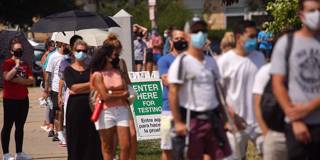The United States should have invested more money in science in recent decades, established a virus and pathogen forecasting service, and built resilient public-health systems on the basis of cost-effective diagnostics. And yet, even though the US did none of those things, it can still limit the damage caused by the pandemic.
WASHINGTON, DC – To escape the clutches of a pandemic, a country needs three things. First and foremost, it needs a sufficient understanding of the disease, including how transmission occurs. Second, it requires access to technology that will deliver a science-based solution: a cure, a vaccine, or some other effective way to prevent transmission. And, third, it must be able to pay for what needs to be done.
Ultimately, this is all about the economics. Has the government invested enough in creating basic scientific knowledge? Are there are sufficient competent scientists in the country to develop an understanding of the disease and its course, and to absorb knowledge from researchers and clinicians elsewhere? Is there a public-health apparatus with adequate resources to address contingencies as they develop? And can everyone afford to protect themselves?
The most devastating pandemic on record is the Black Death – the wave of bubonic plague that swept Europe in the fourteenth century, killing perhaps one-third of the population. No one at the time had a grasp on the cause: most likely, a bacterium carried by fleas that lived on rats. Before modern science revealed the cause of disease outbreaks, humans were largely defenseless against pathogens.

WASHINGTON, DC – To escape the clutches of a pandemic, a country needs three things. First and foremost, it needs a sufficient understanding of the disease, including how transmission occurs. Second, it requires access to technology that will deliver a science-based solution: a cure, a vaccine, or some other effective way to prevent transmission. And, third, it must be able to pay for what needs to be done.
Ultimately, this is all about the economics. Has the government invested enough in creating basic scientific knowledge? Are there are sufficient competent scientists in the country to develop an understanding of the disease and its course, and to absorb knowledge from researchers and clinicians elsewhere? Is there a public-health apparatus with adequate resources to address contingencies as they develop? And can everyone afford to protect themselves?
The most devastating pandemic on record is the Black Death – the wave of bubonic plague that swept Europe in the fourteenth century, killing perhaps one-third of the population. No one at the time had a grasp on the cause: most likely, a bacterium carried by fleas that lived on rats. Before modern science revealed the cause of disease outbreaks, humans were largely defenseless against pathogens.